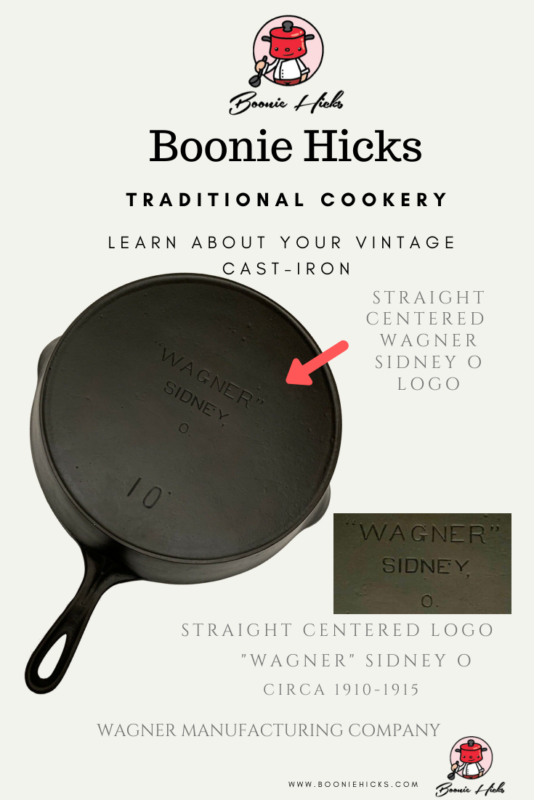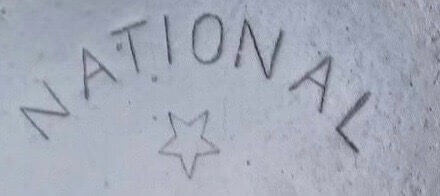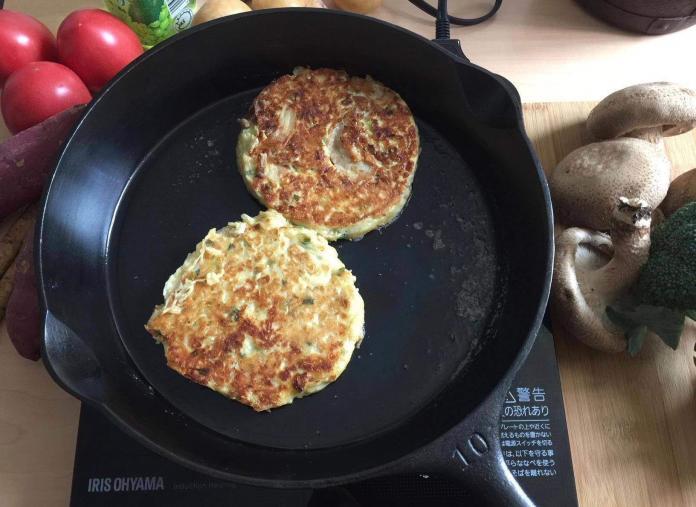Wagner cast iron cookware is regarded by many as some of the finest examples of 19th and 20th century cast iron. Much of the cast iron is over 100 years old and still usable today. These antique pans are sought-after by enthusiasts who prefer vintage cast iron to newer pans. But identifying and dating these old Wagner Ware Sidney -o-pans can be tricky.
So, with this article, I hope to help you and other proud owners identify and give an estimate of the age of your cookware. You can also learn the history of your cast iron, which the Wagner Manufacturing Company manufactured.
Table Of Contents
- Wagner cast iron. “Why is it so collectible?”
- Learn the history of the Wagner Manufacturing Company.
- Where you can buy Wagner cast iron.
- Considerations when purchasing Wagner cast iron cookware.
- You can identify and date antique Wagner cast iron using trademarks and logos.
- Final thoughts on collecting vintage Wagner Ware cast iron.
But first, here is a quick look at the Wagner Manufacturing Company.
Identify And Date Your Wagner Cast Iron Skillets Using Logos. Also, Learn The Fascinating History Of Wagner Manufacturing.
Background To Wagner Manufacturing Cast Iron.
Founders | Milton M. Wagner and Bernard P. Wagner |
Operational Dates | The foundry in Sidney operated from 1891-1959 |
Located | The Wagner Manufacturing foundry was in Sidney, Shelby County, Ohio. |
Product Line | Wagner was one of the largest American manufacturers of cast iron products in the 20th century. Their product line included skillets, kettles, bean pots, Dutch Ovens, roasters, fruit presses, scoops, broilers, Griddles, waffle irons, muffin pans, and cornbread pans. The company also had a range of aluminum cookware. |
Wagner Brands | Wagner labeled their cookware under the following names: Wagner, Wagner Ware Sidney -o-, Wagner Ware, National, Long Life, Magnalite, Wardway, and Ward’s Cast Iron. |
Signature Products | Wagner is best known for the Sidney -O- range of skillets and Dutch Ovens. |
Reason For Closure | The reason for the closure of the foundry came from two fronts. Firstly, the Wagner family sold their interests in the company in 1953 to the Randell Company. Secondly, the company struggled financially because of a drop in sales. The decline in sales was due to two World Wars, the Great Depression, the development of new cookware materials, and the increase of lower-priced imports from Asia |
Wagner After Buyout (Non-Collectible) | In 1957, the Randall Company purchased long-term competitor Griswold from McGraw Edison. The Randall Company sold the cast iron businesses to Textron Corp in 1959. General Housewares Corporation bought Textron in 1969. In 1994, the production of Wagner Ware ended. |

Why Is Wagner Cast Iron Collectible?
Super Smooth Cooking Surface.
Wagner cast iron is highly collectible. Like most antique cast iron, Wagner manufactured high-quality cookware for their entire range of cast iron products.
Unlike Wapak cast iron ironware, it often has characteristic casting flaws. Wagner cast iron tends to have a few casting flaws, resulting in very smooth cookware on both the interior and exterior of the cookware.

Focus On Quality
Imagine that workers would have worked on individual pieces of ironware. It was machined to smooth the interior and exterior of each pan. You can only see this level of detail in high-end cast iron cookware such as Le Creuset and Staub.
Today, Le Creuset and Staub benefit from combining traditional and modern manufacturing methods. However, the workers at Wagner could make cast iron cookware without casting flaws or bubbles. Must have taken great skill and attention to detail.

Wagner Made A Wide Range Of Cast Iron Cookware.
You can’t go wrong with an old Wagner cast iron skillet. It will serve you well for years, and they’re great fun. However, you may want to consider a Wagner Dutch oven. They are super smooth, and just like the skillets, they are reasonably priced. You can also buy cast iron muffin pans, which can be pretty cheap. But watch out for shipping costs that can increase the overall price drastically. Some of Wagner cast-iron cookware range includes:
- Dutch ovens
- Griddles
- Gem pans
- Waffle irons
- Skillets
You can even collect Wagner cast iron cornbread pans that look like corn cobs. Wagner Manufacturing also produced aluminum cookware, which must have seemed revolutionary.
Collect Your Favorite Logo.
If you want a vintage skillet, then Wagner skillets are a great choice. You can choose from sixteen different logos and trademarks or markings. I like pans with heat rings, while others may prefer a pan with a smooth base.
I think this wide selection makes Wagner cookware more collectible than other manufacturers, such as Vollrath and Martin Stove and Range, which manufacture a limited range of products.

Wagner Manufacturing Company Focused On Quality Over Quantity.
Quality was a focus from the very start for Wagner Manufacturing Company. They even advertised this selling point to consumers. Old advertisements read;
We do not strive to manufacture hollowware as cheaply as possible but as well as it can be made. We cannot afford to put on the market ware that will not sustain our reputation. The name Wagner is on the bottom of each piece of ware.
Wagner Manufacturing Company History
Founders And Foundry
Who Founded Wagner Manufacturing? | Wagner Manufacturing Company was founded in 1891 by Milton M. and Bernard P. Wagner. However, two more Wagner brothers, Louis and William Wagner, joined the company in the following years. Another key player in the foundation of the company was R. Bingham. Bingham previously worked at Marion Stove Company and the Sidney Manufacturing Company. |
Where Was Wagner Cast Iron And Wagner Ware Made? | The company had its ironworks in Sidney, Shelby County, Ohio. Early cookware from Wagner Manufacturing had a simple Wagner marking on the back of the ironware. Wagner included Sidney O. in their cookware around 1895. The term Wagner Ware first appeared in the logo in the 1920s. |

The Wagner Product Line Added Nickel Plating, Aluminum, And Magnalite.
Nickel-Plated Cast Iron | To complement their cast iron range, Wagner added a nickel-plated range. Unlike cast iron and copper pots, nickel plating does not react to acidic foods such as tomatoes, which can taint food. It’s easy to look past the development of nickel-plating. But, in the 19th century, bonding two metals together would have required much metal casting expertise. |
Aluminum Cookware | Along with nickel-plated cast iron, the Wagner brothers in 1894 manufactured a line of aluminum cookware, and Wagner Manufacturing was one of the first companies to do so. |
| Aluminum Cookware Exported To Europe | By 1913, Wagner cast iron and aluminum products were selling in Europe. |
| Magnalite | In the 1930s, Wagner manufactured a cookware line with a patented aluminum alloy called Magnalite. |

Wagner Manufacturing Buys Their Sidney Competition.
| Wagner Bought Sidney Hollowware Company. | In 1897, Wagner bought the Sidney-based competitor Sidney Hollow Ware Co. from the founder and owner Phillip Smith. Sidney Hollow Ware made high-quality cast iron cookware that was extremely light and smooth. Sidney Hollow Ware Co. was also an early adopter of nickel-plating cast iron. |
Why Did Wagner Buy Sidney Hollow Ware Company? | It was a brilliant idea to buy the Sidney Hollow Ware Company. After all, Wagner Manufacturing and Sidney competed in the same city and made comparable products. However, it was common knowledge that Smith made a tidy profit from his original investment in the foundry. To run the Sidney Foundry, William H. Wagner joined the family business to oversee the operation. |
Wagner Sold Sidney Hollow Ware Back To Phillip Smith. | In 1903, Wagner Manufacturing sold the Sidney Hollow Ware Company to the founder, Phillip Smith. Sadly, Phillip Smith did not reopen the foundry due to health reasons. |

Wagner Introduced A New Product Line To Stop A Decline In Sales.
| The Great Depression (Magnalite) | I have to take my hats off to Wagner because they introduced a new product line called Magnalite in one of the deepest recessions the world has ever seen. Wagner Manufacturing was steadfast in making only quality products. For this reason, the cookware is collected and highly usable. |
| The Sales Decline | Wagner introduced Magnalite to stop falling sales at Wagner Manufacturing; it was not due to their product range. Magnalite was hugely popular, but it could not offset the effect of the worldwide recession. From 1929-1941, the US was in the grips of what we now call the Great Depression. Therefore, it was not only Wagner. However, many foundries struggled financially to survive. Many didn’t. |

The Family Sells Their Interest In The Foundry.
Wagner Family Sells The Company To Randall Corp. | Wagner Manufacturing Co. lasted longer than many foundries. However, in 1952, Wagner was sold to the Randall Company. Unbelievably, the Randall Company was a car parts manufacturer. |
Textron Buys Randall | In 1959, another business called Tetron bought Wagner. Textron also purchases Griswold Manufacturing Company. At this date, cast iron enthusiasts consider this the end of Wagner Ware production. Wagner cast iron pans made after this date are considered not collectible. |
General House Wares | General Housewares Corporation in 1969 bought the rights of Griswold and Wagner. |
Is Wagner Ware Still Made? | With the world rediscovering cast iron cookware, will we see Wagner Ware skillets manufactured again? General Houses Ware stopped the manufacture of Wagner Ware in 1994. However, there is a glimmer of hope for Wagner Ware. In 2014, American Culinary bought both the Wagner and Griswold trademarks. So, fingers crossed, cast-iron fans may one day decide to manufacture Wagner cast iron again. |
Where Can You Get Your Hands On Some Wagner Ware?
- Grandparents (best deal and great to keep your heritage in the family).
- Antique stores (check online to compare the store price).
- Garage sales (rescue those poor skillets from the tip).
- Flea markets (search the markets for hidden gems).
- Online (largest selection available; however, asking prices can vary greatly.

Buying Considerations Before You Buy Antique Wagner Ware
There Is Plenty Of Wagner Cast Iron Around, So Take Your Time.
There is no shortage of Wagner cast iron. Wagner had a large percentage of the cookware market back in its heyday. And plenty of fantastic Wagner skillets and Dutch ovens are in excellent condition.
What Size Skillet Or Dutch Oven Suits Your Needs?
The first thing you may want to think about is the size you need. There are often plenty of #8 skillets around. This size seems to be the most common for Wagner skillets and other vintage cast iron manufacturers, such as Favorite Piqua.
Inspect Carefully Since A Lot Of Wagner Ware Is Nickel-Plated.
Check the cookware carefully. The Wagner Manufacturing Company was an early adopter of nickel plating. However, most of Wagner cookware is unplated iron. Heavy seasoning may hide nickel plating. Nickel-plated can wear off or be patchy in places. Take a close look before purchasing.
Would You Like A Wagner Ware Skillet With A Smooth Bottom Or Heat Ring?
Do you want a pan with a smooth bottom or one with a heat ring? The older Wagner Ware skillets will have a heat ring, while the later-made pans have a smooth, flat base. It is a personal preference. I tend to like the older skillets with heat rings. They have more character, but the smooth-bottom Wagner cookware tends to be a little cheaper. And they are great cooking pans, too.
Does The Cookware Sit Flat?
As with all antique cast iron, asking the seller if the pan sits flat could be a good idea. A lever base is practical if cooking on a flat surface such as induction or glass.
Learn To Date And Identify Your Wagner Cast Iron Using Logos And Markings.
Although I’ve researched carefully, please only use the dates as an approximation.
Wagner cast iron cookware, to my knowledge, has sixteen known logos, brands, or markings. These include:
Straight Wagner Logo 1890s-1915


Wagner Arc Logo 1891-1910


Double Arc Wagner Sidney O 1895-1915

Sidney Arc logo Circa 1897-1903.

Straight Sidney Logo Circa 1897-1903.


Straight Wagner Sidney O. (Centered.) 1910-1915

Wagner Sidney O. Wagner Slightly Arced While The Sidney Lettering Is Straight. Circa 1915-1920s

First Wagner Ware Sidney O. With Arc Wagner And Straight Ware And Sidney. Circa 1920s.

Stylized Wagner Ware Sidney O. for regular skillets. Circa 1920-1924 with heat ring and single-digit size number. 1924-1935 with a heat ring and a four-digit pattern number. Around 1935-1959, for skillets with no heat ring.


Centralized Stylized Wagner Sidney O. 1924-1935 With Heat Ring.

Pie Logo 1924-1934. However, Manufacturing Dates Are Uncertain.

National Cast Iron Dates Between 1914 and 1940s
There are several different versions of cast iron with the National marking. Wanger marketed the Nation brand as entry-level cookware for budget-conscious consumers. Wagner made the National line circa 1914 to 1940.


Long Life Logo 1930s.

Wardway and Montgomery Ward. The Montgomery Ward Department store contracted Wagner Manufacturing Company to produce an in-store label. Circa the 1930s.



Final Thoughts On Wagner Cast Iron.
Fortunately, Wagner cast iron is more straightforward to date than other foundries of the time. Wagner Ware also has a huge collector base, so dates are well documented. The Cast Iron Collector is a valuable online resource for enthusiasts. Also, there are Facebook groups where you can share your love of cast iron cookware.
The Wagner Manufacturing Company was known for quality over quantity. Therefore, it has a good reputation for making trustworthy products.
Today, collectors and enthusiasts seek out Wagner cookware. However, you don’t need to be a collector to enjoy vintage cast iron. Here are six reasons why Wagner Ware is excellent ironware.
Although many cast iron enthusiasts look for Wagner-made skillets. But you’re not limited there. Wagner Manufactures a wide selection of cast iron cookware. You may find yourself becoming interested in:
- muffin pans
- Dutch ovens
- Scotch bowls
Since Wagner made some of the finest cast iron of the 19th and 20th centuries, Wagner ironware is still sought-after by cast-iron fans and hobbyists alike.









Hi,
I was gifted a square Wagner Ware skillet, one of my most prized possessions. I’d love to know more about it. Wagner is arched, and the W is for both Wagner and Ware. Sidney -O- is beneath that. A little further down, it says Square Skillet and is marked 1218 E at the bottom. Any idea how old it may be?
Hi Raegan
There are a couple of Wagner Ware Square skillets and differences in the thumbprint on the handle. But it looks like Wagner Ware made most of these skillets between 1930 and 1960.
I hope this helps and enjoy your skillet.
Hello! Could you help me identify/date a vintage Wagner Ware deadstock 10″ preseasoned ready-to-use double-spouted skillet? It is a #8 pan, marked 1058H.
Thanks so much for your help!
Hi Carolynn
Wagner used the pattern number 1058 to indicate the type of cookware and the size. But you can use ts gude for Wagner Ware Sidney O skillets.
If you can not find a skillet with your logo, it’s probably a post-1950s skillet. And Likey your pan is made in the 1960s or 1970s. These skillets are missing the Sidney -O- under the Wagner Ware logo.
I hope this points you in the right direction,
Hello, I was passed down a Bacon and Egg Breakfast Skillet with no thumb spot. It has at the bottom 1101A14 with a dash or underscore under the “4” with Pat. Pending under that.
I am looking forward to your knowledgeable replies. Thanks.
Matt.
Hi Matt
There are a few variations of the breakfast skillet. But it sounds like you have an early design dating to the 1920s. Some enthusiasts might pinpoint the design to 1925.
Enjoy your skillet.
I lived for thirty+ years in Sidney, O. A friend recently gave me a teapot, and I am trying to find the date. Arced WAGNER, straight WARE, straight SIDNEY with a comma, O in the middle, production number 211, and finally 1 PT. It has a wooden handle, a hinged lid, and a spout like the bigger teapots. I wondered if it might be made special for employees as a holiday gift.
Dear Molly and Charles
Thanks for your question. I’m unfamiliar with antique aluminum ware but found your teapot after some research—your Wagner Ware teapot with a side handle and the marking 211 dates from the 1910s to the 1930s.
I hope this helps, and enjoy your teapot
Thank you for your information on both the Wagner and Griswold ironware. I have inherited some pans from my father-in-law and have taken them down to the bare metal using electrolysis. What a joy it was to be able to date my pans!
Hi Bry
Thanks for letting me know you could use my articles to date your antique ironware. Great to know. Sounds like the pans have gone to a good home.
Have fun using your vintage skillets.
Hi,
I have my grandmother’s bacon and egg. I am trying to date it. Wagner is arched, and the W is for both Wagner and ware Sidney O 1101 A10 patented, depending.
My grandmother passed away in 1987, and since I was a small child, she used the pan. She also used it to make pancakes.
Hi Cynthia
I did a little research on your bacon and egg skillet, and it looks like it could be from the mid to late 1920s. A reference book pinpointed this skillet circa 1925; however, they were likely for sale after this date.
I trust this helps, and it sounds like the skillet is in good hands.